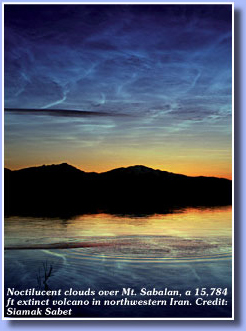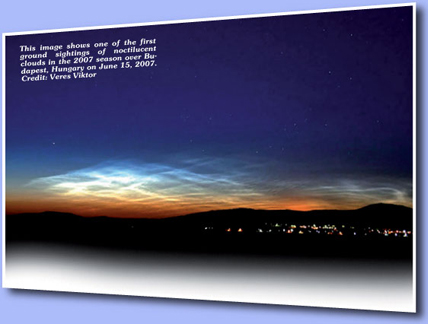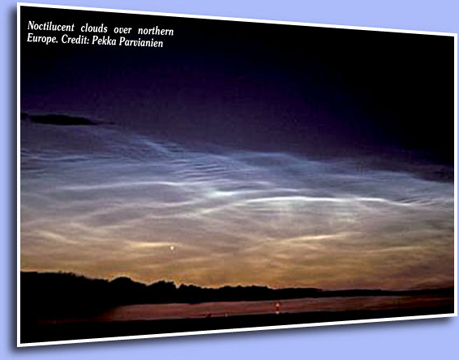  
by Tariq Malik
An eerie cloud that glowed
briefly in the night sky Saturday was no UFO. It was created by humans -
more specifically a NASA rocket built to make clouds that shine at
night.
The rocket launched as part of an experiment to artificially create
so-called noctilucent - or night-shining - clouds, the highest clouds on
Earth. They naturally appear around 50 miles (80 km) above Earth’s high
latitudes and are also known as polar mesospheric clouds.
Saturday night’s rocket experiment lifted off at 7:46 p.m. EDT (2346
GMT) from NASA’s Wallops Flight Facility on Wallops Island, Va. It
created a brief light show that was visible across the United States’
East Coast and sparked calls from curious skywatchers as far away as
Boston, according to the Associated Press.
 “It was very impressive ... albeit short-lived,” said Joe Rao, an
instructor and guest lecturer at New York’s Hayden Planetarium, who
witnessed the event. Rao is also SPACE.com’s skywatching columnist. “It was very impressive ... albeit short-lived,” said Joe Rao, an
instructor and guest lecturer at New York’s Hayden Planetarium, who
witnessed the event. Rao is also SPACE.com’s skywatching columnist.
The experiment created a man-made noctilucent cloud using the fourth
stage of a NASA Black Brant XII suborbital sounding rocket that spewed
exhaust particles 173 miles (278 km) above Earth. Ground-based radar and
camera stations recorded the resulting cloud’s formation and
illumination.
The U.S. Naval Research Laboratory and Department of Defense’s Space
Test Program oversaw the launch, which it called the Charged Aerosol
Release Experiment.
NASA has observed naturally occurring night-shining clouds using its
AIM satellite. The Naval Research Laboratory and Space Test Program also
uses a satellite called STPSat-1 to observe the phenomena and also used
the spacecraft to observe Saturday night’s man-made cloud.
“We weren’t exactly sure what we were going to see, as this was the
very first time that a noctilucent cloud experiment was attempted,” Rao
said. “Would it be something obvious to the eye, or something rather
faint?” The result, he added, was spectacular.
Rao described the cloud as “a brilliant object” that displayed a
wide, fan-shaped tail shortly after it was created. But the artificial
phenomenon was over in just a few minutes.
 “The “head” of the comet (which was the rocket’s fourth stage)
rapidly faded out and the “tail” gradually faded over the next minute or
so into the background of the sky,” Rao said. “The “head” of the comet (which was the rocket’s fourth stage)
rapidly faded out and the “tail” gradually faded over the next minute or
so into the background of the sky,” Rao said.
Scientists will use the measurements of the artificial cloud to
better understand natural noctilucent clouds, as well as help predict
the effects of rocket engine exhaust in the upper atmosphere.
Saturday night’s experiment was a cooperative effort by NASA, the
United States Naval Research Laboratory, the Defense Department’s Space
Test Program and several universities. But the stunning cloud it created
was seen by more than just the project’s scientists.
“I’m sure many unsuspecting folks up and down the East Coast were
surprised by this very unusual sight,” Rao said.
- www.space.com |

